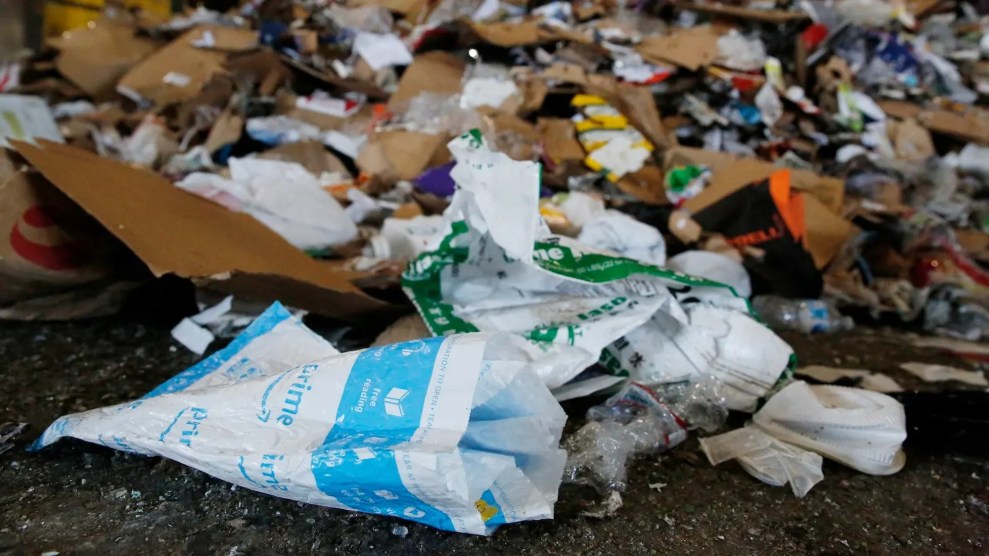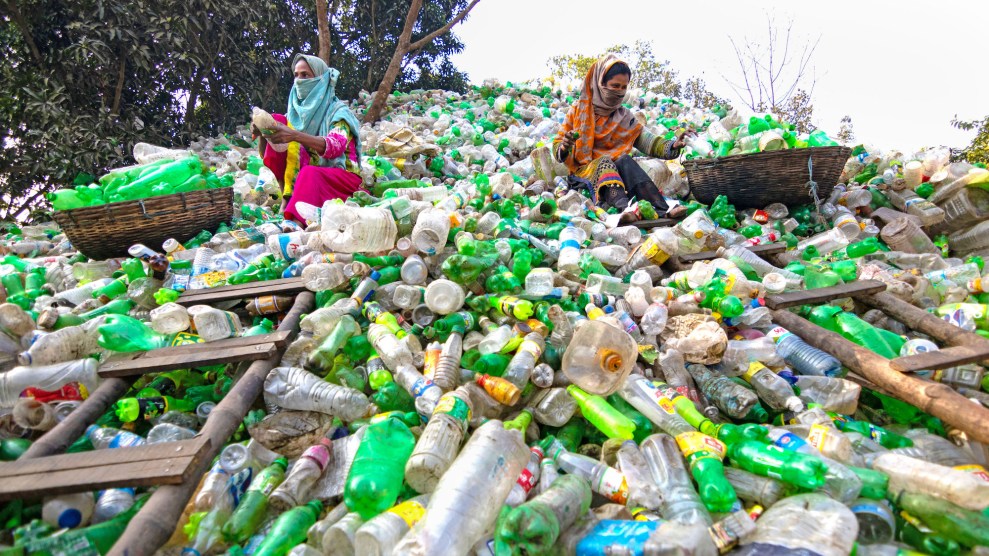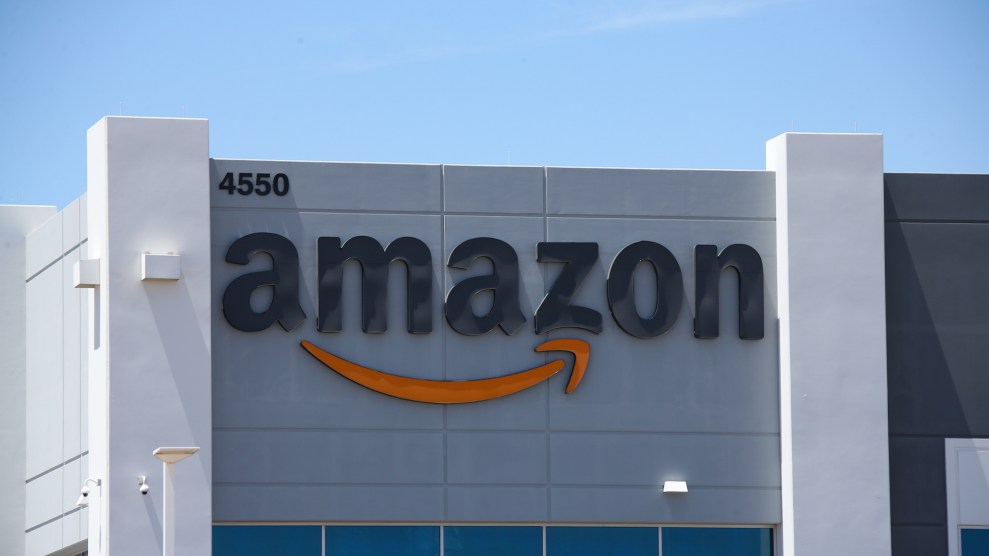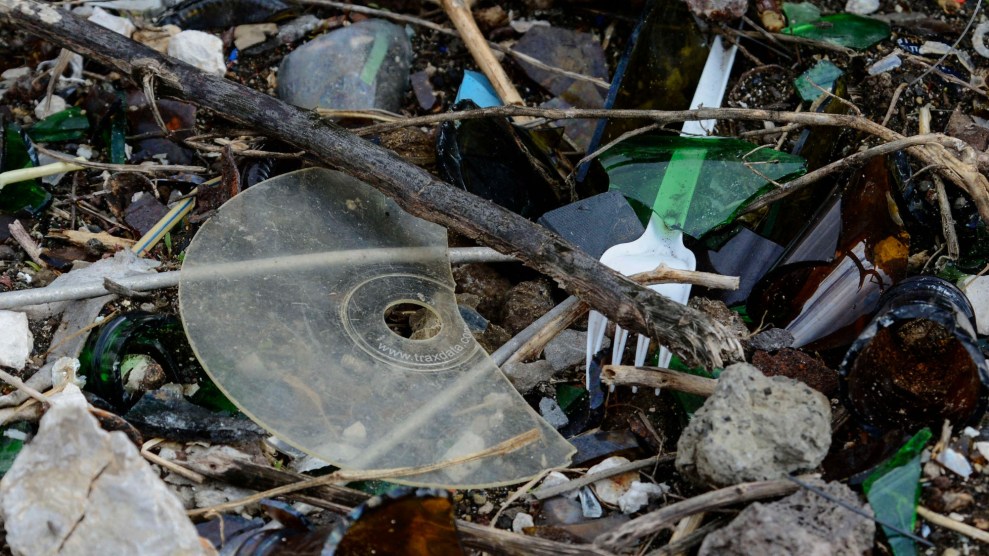
Lea Suzuki / The San Francisco Chronicle via Getty Images via Grist
This story was originally published by Grist and is reproduced here as part of the Climate Desk collaboration.
In response to growing pressure to address the plastic pollution crisis, Amazon has been cutting down on plastic packaging. Last July, the company said it used 11.6 percent less plastic for all of its shipments globally in 2022, compared to 2021. Much of Amazon’s reductions took place in countries that have enacted—or threatened to enact—restrictions on certain types of plastic packaging. But the company’s progress may not extend to the US, which has not regulated plastic production on a federal level.
Amazon generated 208 million pounds of plastic packaging trash in the United States in 2022, about 10 percent more than the previous year, according to a new report from the nonprofit Oceana. This packaging includes Amazon’s ubiquitous blue-and-white mailers, as well as other pouches, bags, and plastic cushioning. If all of it were converted into plastic air pillows and laid end to end, Oceana estimates it would circle the Earth more than 200 times.
“The crisis is so significant that we need change now,” said Dana Miller, Oceana’s director of strategic initiatives and an author of the report.
Miller and her co-authors are calling on Amazon to stop using plastic packaging in the US, citing phaseouts in some of the company’s biggest overseas markets as evidence that such a transition is possible. Amazon has done “some pretty impressive things in Europe and India, but in the US they are not making the same sort of commitments,” Miller added. “The company has made great progress, but it’s just not enough.”
To calculate Amazon’s US plastics footprint, Oceana used market research on the amount of plastic consumed in 2022 by the American e-commerce industry—more than 800 million pounds — and multiplied that by Amazon’s share of the market, 30.5 percent. Oceana then made some downward revisions to account for Amazon’s publicly disclosed efforts to reduce plastic packaging. For instance, in 2022, Amazon said it replaced 99 percent of its mixed-material mailers with paper ones and delivered 12 percent of its US shipments in 2022 without adding any of its own packaging.
The resulting estimate, 208 million pounds, is about 11 times the weight of Seattle’s most iconic landmark, the Space Needle.
This is worrisome because the type of plastic typically used in Amazon packaging—known as “film”—is almost never recycled. Most of it is sent to landfills or incinerators, or is discarded into the environment. According to one 2020 study, plastic film is among the most common forms of marine plastic litter near ocean shores, where it kills more large marine animals than any other type of plastic. Oceana estimates that 22 million pounds of Amazon’s global plastic packaging waste generated in 2022 will end up in aquatic environments.
Plastic production causes additional concerns. The extraction of fossil fuels used to make plastic, plus the conversion of those fossil fuels into plastic products, releases carbon and air, water, and soil pollution that disproportionately affects low-income communities and communities of color.
Miller said she’d like Amazon to reduce plastics “because of a moral responsibility … to reduce their impact on the environment.” But the company has been slow to respond to moral appeals from customers and shareholders, including three shareholder resolutions since 2021 invoking plastics’ damages to marine ecosystems and human health. The resolutions, which each received more than 30 percent of shareholder votes, asked Amazon to cut plastics use globally by one-third by 2030. When announcing that it had cut plastics use globally by 11.6 percent, Amazon did not make a quantitative or time-bound commitment to further reductions.
Instead, Amazon seems to have taken its biggest steps to reduce plastic packaging in response to stringent plastic regulations, or the threat of them. “Amazon is a clever company,” Miller said. “They see things in the pipeline and they want to move early.”
In 2019, for example, Amazon India pledged to phase out plastic packaging after Prime Minister Narendra Modi called on constituents to “make India free of single-use plastic,” hinting that he would announce major restrictions on the material later that year. Within months, Amazon India said it had eliminated plastic packaging from the country’s fulfillment centers, replacing it largely with paper.
In the European Union, a directive on single-use plastics has made it unlawful since 2021 to sell several types of single-use plastic, including bags, and after a long drafting process, the bloc last month agreed to “historic” targets to reduce packaging waste by 15 percent by 2040. Amazon said in 2022 that it had eliminated single-use plastic delivery bags at its fulfillment centers across the continent.
Despite efforts from progressive lawmakers, the US still lacks a federal plan to phase down plastic packaging, which could help explain why Amazon hasn’t acted more aggressively on the issue stateside. A spokesperson for the company told Grist last month that Amazon has started a “multiyear effort” to transition US fulfillment centers from plastic to paper packaging, but the company has not announced a timeline for that transition.
Then again, Amazon’s American presence is also much larger than its operations overseas; the fact that US orders make up nearly 70 percent of Amazon’s total sales may make it more complicated to change packaging materials here.
“It would be a bigger deal for them to eliminate plastics in the United States,” said Jenn Engstrom, director of the California chapter of the nonprofit US Public Interest Research Group, who was not involved in the Oceana report. “But they’re also one of the most innovative and biggest companies in the world; just because it’s hard to do doesn’t mean they shouldn’t do it.”
Amazon, the largest e-commerce company in the world, sold more than half a trillion dollars’ worth of goods last year. Its main American competitor, Walmart, said last month that it had eliminated single-use plastic from its mailing envelopes globally. In China, the retailer JD.com is replacing disposable packaging altogether with reusable alternatives.
Engstrom pointed to some some state-level policies that could affect Amazon’s plastics use—most notably in California, where a law enacted in 2022 requires that companies reduce their overall packaging distributed in the state by 25 percent by 2032. Washington state tried to pass a similar law last year, but the proposal died in committee. Five other states have passed less specific bills on “extended producer responsibility,” or EPR, that attempt to make plastic producers financially responsible for the waste they generate—often by having them fund improvements in recycling infrastructure.
Although Amazon is funding several efforts to improve plastics recycling, Oceana says that this is “not the solution the company should be relying on.” Plastic film cannot reliably be recycled due to technical and economic constraints; virtually no curbside recycling program accepts it. In a best-case scenario, plastic film can be downcycled into plastic decking material or benches, but recent investigations suggest that store drop-off programs meant to facilitate this process often end up dumping Amazon packaging in landfills or burning it in incinerators.
When American consumers mistakenly put Amazon’s plastic packages in their curbside recycling bins—as many do—a 2022 Bloomberg investigation found that they may end up at illegal dump sites and industrial furnaces in Muzaffarnagar, India, with potentially dire consequences for nearby residents’ health.
Pat Lindner, Amazon’s vice president of mechatronics and sustainable packaging, called Oceana’s study a “misleading report with exaggerated and inaccurate information,” and told Grist that Amazon is committed to reducing its plastic footprint at US fulfillment centers. A spokesperson said the company is proud of reducing its plastic footprint in Europe and India and that it would continue to share updates on its progress in the US. The spokesperson also said Amazon is committed to good-faith engagement with shareholders on plastic-related resolutions.
Oceana said the company declined the nonprofit’s requests for country-level data on its plastics use. The company also declined to share data on plastic packaging used in third-party shipments; Amazon’s disclosures for plastic packaging used in 2021 and 2022 only account for packages shipped from Amazon fulfillment centers.
“We are hoping that Amazon will provide more detailed data…and illuminate some of these questions,” Miller said.















